Another year has passed, the Mojave Desert's Johnson Valley OHV Area was saved, 40,000 spectators moved into the sand and scrub for a week of man-against-the-end-of-the-world racing, we have recently returned and even more recently recovered from another week on the Means Dry Lake Bed witnessing the King of the Hammers.
If you aren't familiar with King of the Hammers (KOH), the short story is that it's one of the hardest races in the world, combining desert racing (100-plus-miles-per-hour through the desert like the Baja 1,000), rock crawling (inching over rocks the size of Chevrolet Suburban SUVs at 3 mph, like Moab) and rock racing (higher-speed rocky sections). That sentence might not seem so bad, but here are the stats: this year's race was 198-miles long; competitors came from 31 states and 8 countries; it took the winner a few minutes more than 8 hours to finish; the time limit for competitors is 14 hours, and out of 158 starters, only 32 made it home before the cutoff. The rest, in the seat for more than 14 hours, were still trying to get their trucks through gargantuan quarry obstacles with names like Sledgehammer, Wrecking Ball and Chocolate Thunder. At 10:00PM. Having been racing in the dark for five hours already. It's that hard.
For the long story, check out our pre-race post and race recap from last year's event, the first time we'd been to KOH and realized that a new Mad Max sequel is made every year on a dry lake bed north of Palm Springs, not in a studio.
Read on to enjoy our report on the race, on last year's King Randy Slawson, and on Autoblog series hosts Jessi Combs and Patrick McIntyre of The List winning one of the week's races using one of the Mopar-powered spec-series rig that you can rent to run the Hammers yourself.
Hammer time hasn't been this awesome since MC wouldn't be touched.
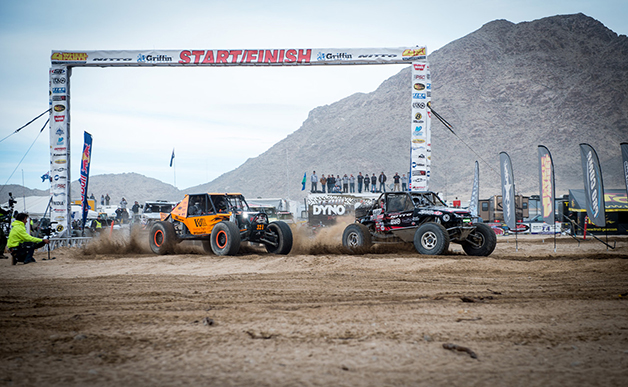
The action goes on for a solid seven days, day and night, during the week of racing known as King of the Hammers. As for the race itself, drivers leave the Start/Finish line in pairs at 30-second intervals. The race is three laps, the first one a big loop out into the desert, the second two being figure-eights through the various rock impasses called The Hammers. Lap 1 was 52 miles through the desert, Lap 2 was 67-miles long, and Lap 3 was 79-miles long because it includes a couple of extra trails that don't need to be done on the previous laps. A driver's choice feature of the race is that they can decide which lap they want to climb a rock trail called Backdoor. Some decide to get it out of the way on the first lap, others wait until the third lap when attrition has hopefully thinned the field.
Loren Healy Is Your New King Of The Hammers
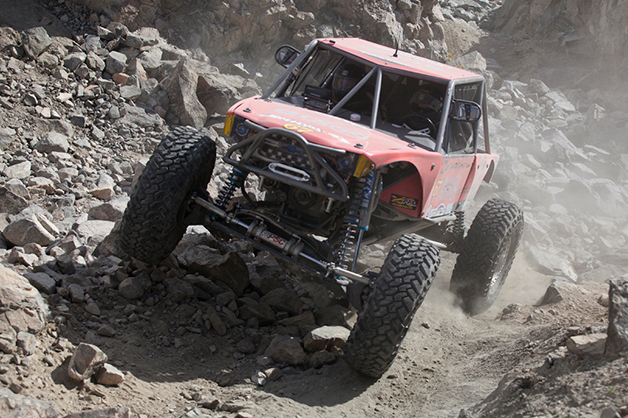
New Mexico man Loren Healy is the second two-time winner of KOH, having won in 2010, after Shannon Campbell did the double in 2008 and 2011. Swapping last year's independent front suspension rig for a solid axle this year, Healy and his co-driver left the line in ninth just after 8:00AM, passed everyone else in front of him over the first two laps and stayed out of trouble until the third lap – up to that point he said, "The day went perfect." The lead had been changing all day between the top qualifiers and a number of former Kings, all battling at the front either on time or physically in the lead and all of whom met misery on the last lap.
Last year's King, Randy Slawson, said, "I've never seen so many lead changes at a KOH race." After a number of early mechanical issues he was in second place with just 30 miles to go before he lost his power steering; the hydraulic steering line had been rubbing against an injector line, wearing a hole in each. Slawson fixed the steering line, which took two hours, but lost a cylinder for the rest of the race and he and co-driver/brother Mike Slawson crossed the line in ninth.
For Healy, halfway through the lap the rear-mounted jack slid out of its mount and "wiped out the radiator," busted a wiring harness and shorted wiring which then burst into flame under the dashboard. He made it to his remote pit, where they cut the radiator in half and filled it with "eight cans of stop-leak and a little bit of coolant," turned on the one remaining fan and he got back in the race.
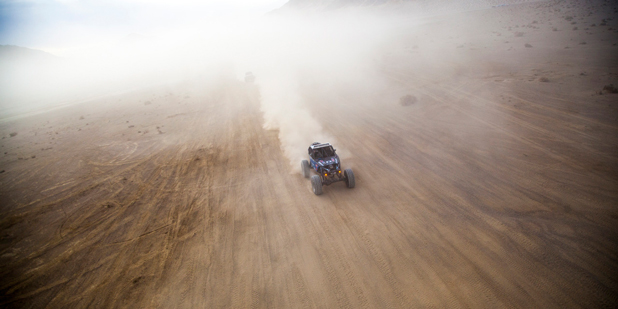
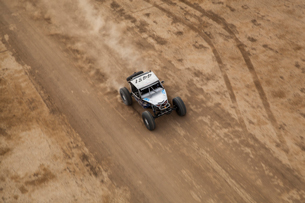
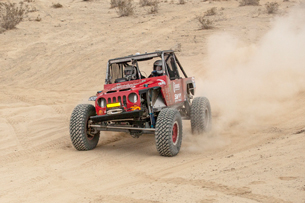
Then he broke his rig's U-joint on the last rock section of the day and was left with a three-wheel drive truck. That meant he had to winch out of terrain he should have been able to drive over. The duo got out of that, then got beached on a sand hill. With nowhere to winch from and in the physical lead Healy thought his race was done, but a backmarker gave him a winch off the dune and he was back in it (competitors can assist one another, but they can't get help during the race from their own teams). He did the last 30 miles with his engine in safe mode, unable to get beyond 2,000 rpm, coolant all gone and the engine temp at 250 degrees. But he did it in first place.
The most succinct thing he had to say about the win that took 8:03.25: "It was brutal, brutal, brutal. That was the worst race I've ever finished."
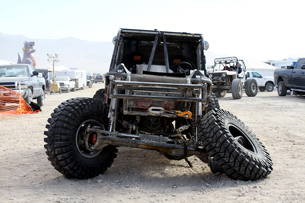
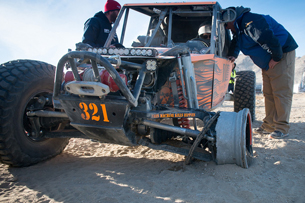
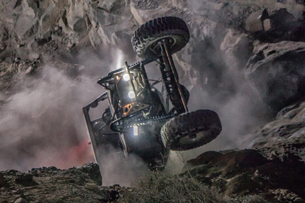
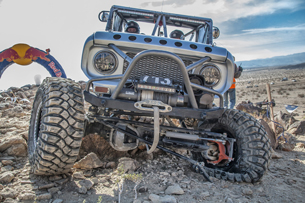
Healy wasn't first across the line, though – that honor went to Tom Wayes, who raced without a co-driver in an IFS buggy that was comically fast all day. Wayes qualified in second place and ran in first place from not long after the start. He didn't carry a spare tire, and he was still so fast – and lucky – that when his front left tire burst several miles before the line, he kept running and crossed the finish on three tires and a rim, still physically in first. But he missed a highway checkpoint and the helicopter caught it when he skipped a rock trail called Elvis, and he was handed a 1:10:00 time penalty that dropped him to seventh place.
That wasn't the only penalty at the front. Healy crossed the line just ahead of Derek West, and since West started about a minute before Healy, West was initially classified in second place. Later, when tracking was pulled from the on-board computer, it was found that West had also missed Elvis and was given a 25-minute time penalty, dropping him to fifth place – a shame for the racer from Missouri and great guy we profiled last year.
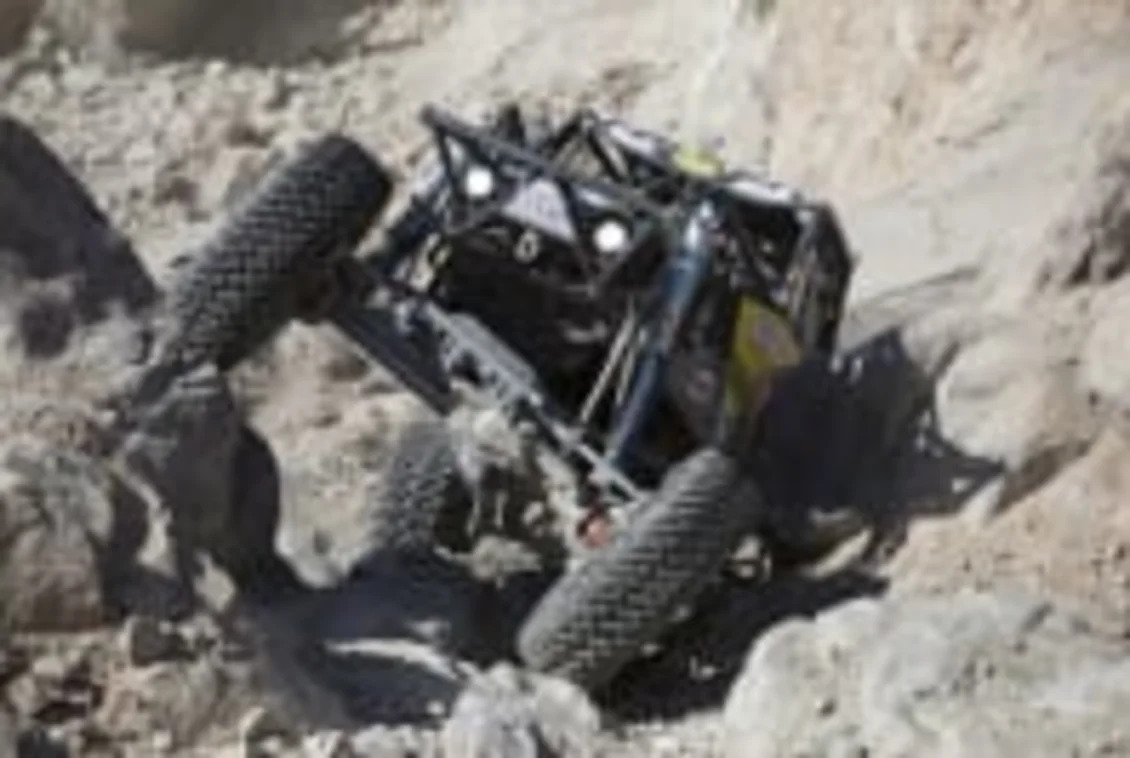
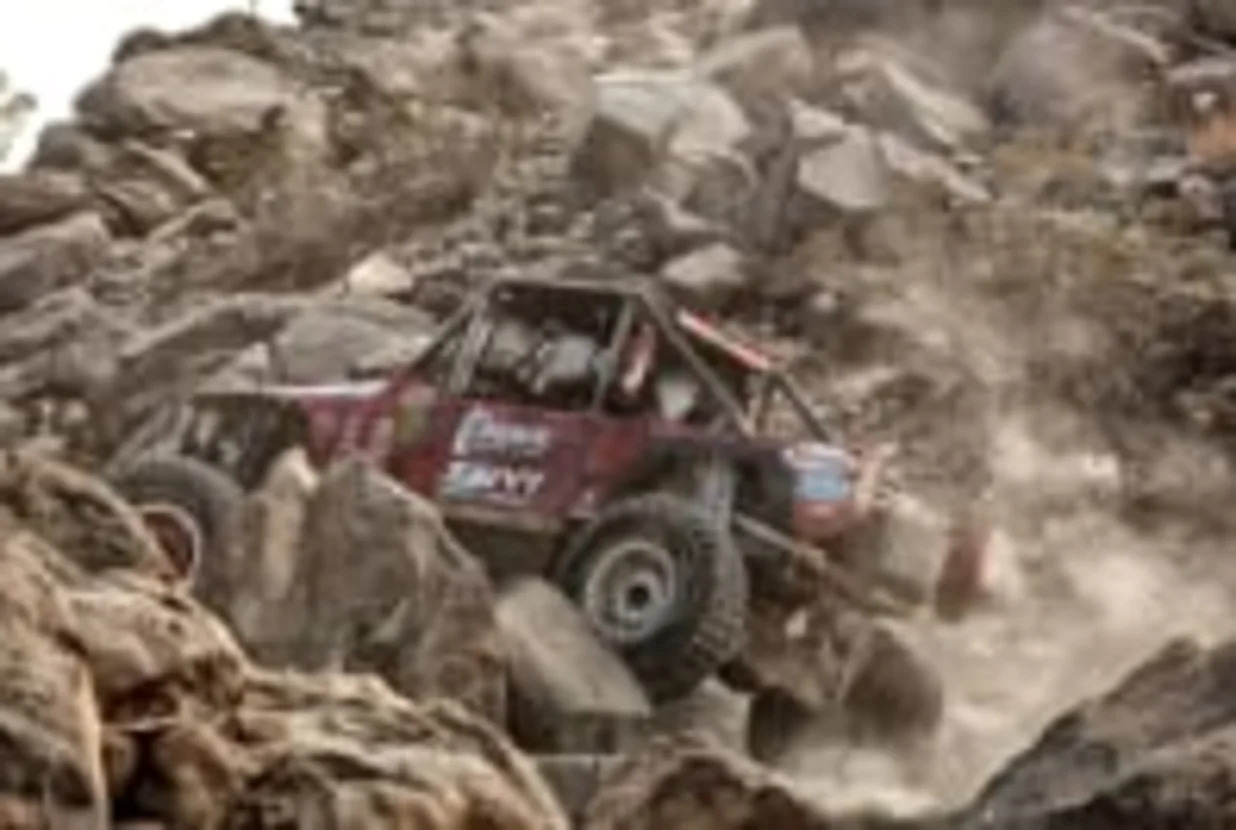
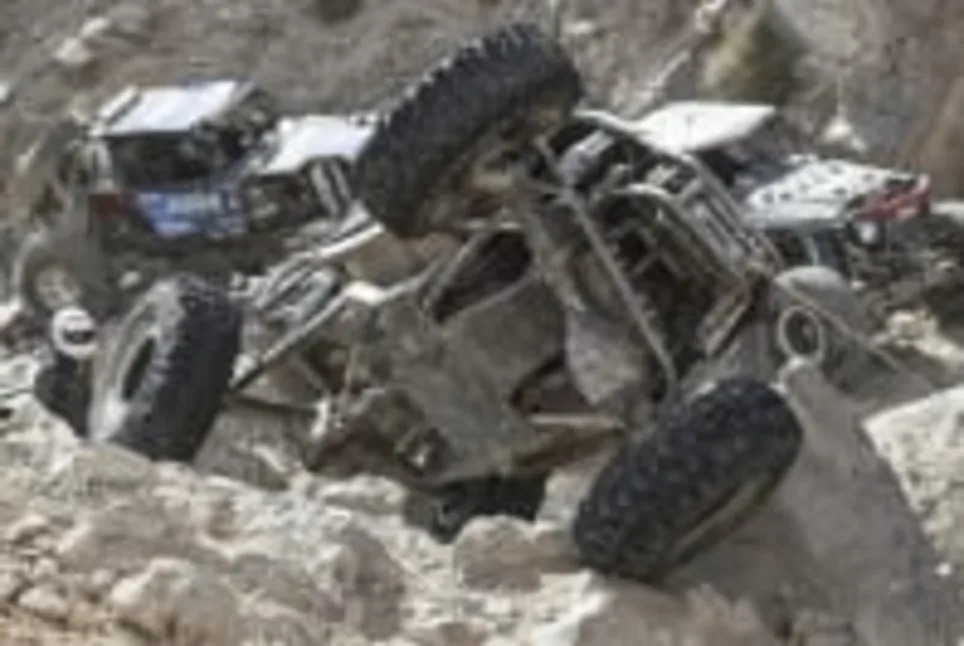
That promoted Tony Pellegrino, owner of GenRight Offroad and another who described his day as "brutal," into second place. Pellegrino, who's finished in second place once before in five starts, said his goal was to "pick people off toward the end without beating up our car. The goal was to get to the end." The penultimate step on the podium is an excellent reward for such a modest goal, at the same time as it shows how much the race can reward a day of soild, steady running.
Bill Baird, at 64 years old, the oldest man in the race, nabbed third on his third time competing after having not even finished the previous two. He also did it driving alone – he winched his own car when needed, he got three flats during the race and was the only guy in the top five without a co-driver. Baird's been racing for longer than many of us have been alive and is a former ARCA Champion, raced stock cars, has done three Sprint Cup races, is in the Talledega Hall of Fame and at some point found time to be a stunt pilot in a Mig-17. Said a hugely excited Baird after the race, "Just because you're getting older doesn't mean you can't do things."
The rest of the top ten and field can be seen at the official timing website. As for other notables, pole-sitter Nick Nelson ran out of gas on Lap 1 and later lost his engine on the same lap. Two-time winner Shannon Campbell blew his transmission on the first lap and was out of the race. He then joined his son Wayland Campbell's pit crew, and helped his son - who's a senior in high school - finish in 15th. Former King Jason Scherer blew his front CV joints on the last lap and bowed out. Former King Erik Miller looked all set for the win with a lead of ten minutes coming into the final stretch, having passed Healy on Lap 3, but blew an orbital valve on a rock section. He ran – physically ran – to his remote pit, got the part, ran back to his rig, fixed it, and crossed the line in 25th, after 12 hours and 44 minutes. That's how the Hammers go.
Last Year's King, Randy Slawson, And Bomber Fabrications
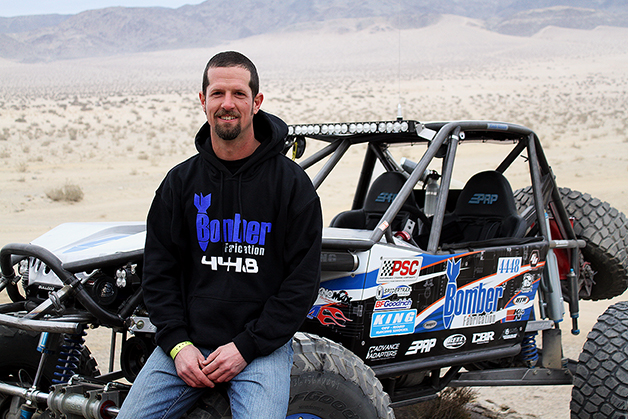
Trying to get more perspective on who the men and women in the helmets are, we managed to get some time with last year's King, Randy Slawson, who won the race with his brother Mike Slawson as co-driver. Racers Channel did an excellent profile on Slawson that deserves a watch.
A laid-back guy originally from Oregon, he moved to California about a dozen years ago and started running The Hammers years before the race began – in fact, it was getting to know guys like Slawson that gave Cole the idea to start the race. This was back when groups would come out with picnics and blankets, planning to spend an entire day getting up just one of the rock trails like Sledgehammer. And that's also part of what made the race so incredible – nobody believed that you could climb a dozen such trails in one day, and the idea of climbing those dozen trails twice, as well as making a high-speed desert run, as well as rock racing, in the same vehicle in the same day... well, that was impossible. But here we are having just finished the eighth running.
He first started running The Hammers in a Toyota pickup he modified himself, and that eventually turned into opening his shop, Bomber Fabrication, to build high-dollar, high-horsepower sand cars (buggies) – they'd sell for anywhere from $50,000 to $150,000 and get 1,200 horsepower from twin-turbo motors.
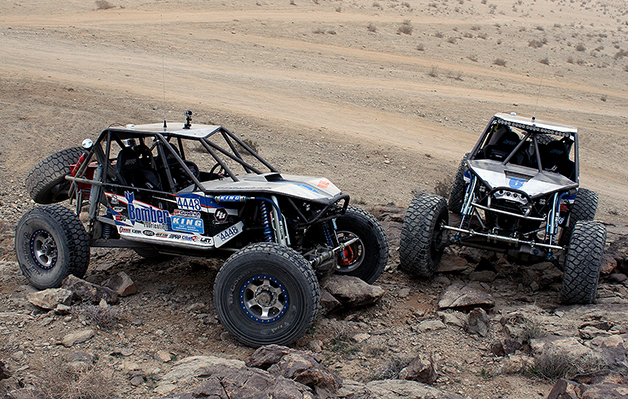
When Slawson says he's one of the few to race and win The Hammers with a car he built, he doesn't mean he has a company that builds his cars for him, he means he's one of the men wielding the tools – Bomber is really just Slawson and one other guy, building rigs to suit Slawson's philosophy. Bomber's pedigree is already impressive thanks to that philosophy – this year there were three Bomber Fab rigs in the race. That success is not surprising considering his ideas echo the words you hear from engineers at car companies like Porsche and Ferrari; designers like McLaren's Gordon Murray and Lotus' Colin Chapman.
"I was working in sand cars and that's where I began to think about building a simple car. I pushed myself to try things." His brother Mike elaborated: "He's adamant about anything that goes on the car. He'd say, 'Do we really need another tube or gusset or weld?,' or 'These reflectors are too heavy. Can we drill holes in them?'"
Every car he's built since his first, in 2008, has been an evolution of the one before. "I don't build two cars the same," he said. "I like things simple. With each car I want to get better with clearances or mountings or whatever." He is also focused: unlike most other competitors, he lives just 90 miles away, KOH is the only Ultra4 race he does and he builds his trucks with the sole intention of winning the scepter.
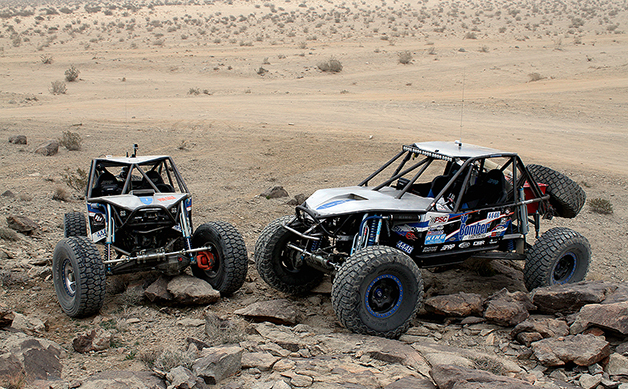
In a sport where the average truck can weight 4,500 or 5,500 pounds, Slawson got his truck down to 3,870 pounds this year. His 2013 victory brought in more sponsors, more customers and more money, and "better components is all about the issue of money," he said. "Of late, that's less of an issue."
The biggest difference between last year's rig and this year's, and where he focused his efforts, is the wheels, axles and driveline. "When your front axle, wheels and tires weigh 1,200 pounds and the rear weighs 800 pounds (the wheels and 40-inch tires alone are 130 pounds), getting the unsprung weight down is huge," he said. The new arrangement has lost 100 pounds in the front, 80 pounds in the back. "I noticed it right away – the wheels move up and down much faster."
Here's the kind of difference a win and a year's worth of sponsorship deals has made. Last year's rig was built in six weeks of 12-hour days and, for a cost-saving example, used eight-lug one-ton-truck hubs that Slawson got from Pick-A-Part at $17 per hub. This year's rig was built in 45 working days with time off for holidays, and uses a fabricated, unitized, 6-bolt unit-bearing hubs, surrounded by custom knuckle guards, bracketing and trusses and a custom steering arm. In back, in the middle of the Spidertrax housing, is a ten-inch, rim-polished trophy truck differential with a 5:43 gear reduction. Hanging out at the ends are 39.5-inch BFG KR2 prototype tires on BTR wheels.
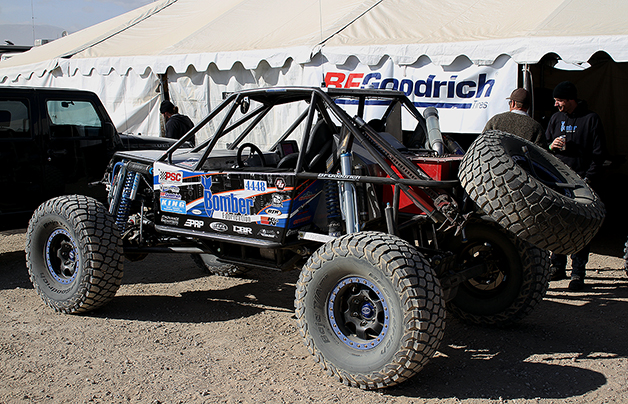
The engine was built by Custom Built Motors, a 6.2-liter LS3 that's been bored out to 7.0-liters (425 cubic inches), with ported and polished heads, and a Bomber Fabrications alternator relocation kit to get the alternator higher up, leaving more room for suspension travel. "The point is to keep engine low and forward and allow for the suspension and driveline, and the 6.2-liter is an amazing starting point," Randy said, "light, compact, well supported in the aftermarket, with a wide power band and no lag." He ran the exhaust up above the engine to make more room below for – yet again – suspension travel, and moved the coils behind the engine to keep the plug wires away from the manifold, then shaved the bosses and powdercoated the valve covers. The 600-horespower motor sends power to a 4L80E, computer-controlled, four-speed overdrive transmission. The cockpit tunnel has one lever for the front differential and one for the rear differential.
The $10,000 worth of custom shocks come from King – Slawson and the suspension company having worked to develop a package specifically for his rig. There's a 14-inch stroke up front, in back there's a 16-inch stroke and 20 inches of wheel travel, 13 of it being up-travel instead of droop travel. A few other notes on the build: the water lines are plumbed into the tube chassis so no extra hoses are required to get water back to the radiator; he has to refill the 26-gallon fuel cell 3 times during the race, but the smaller cell means the back end loses less weight and the truck behaves more consistently when the cell is full or nearly empty; has to refill three times, weight is a big deal, tune the truck for a bigger cell then you lose the weight the truck acts differently; he uses a go-kart steering wheel "because I like the size;" he calls his front bumper "The chrome horn."
Before the race, Slawson couldn't peg the odds on a victor. "If I could make a bet for a million bucks who is going to win this year, I couldn't narrow it down." Even though the mechanical issues dropped him to a ninth-place finish, Slawson said afterward "I was in and out of the car all day long dealing with 'new-car blues,' but I've never had such a fast car." It's likely we'll see it again next year – refined, of course. And it's probably safe to bet a million that – eventually – we'll see him as King again.
Autoblog's video series "The List" Demonstrated Mopar-Powered Hammering
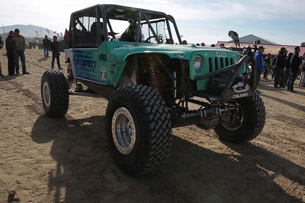
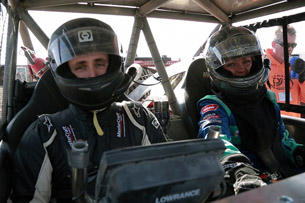
The rig in the pic above is #4703 in the 114-mile Smittybilt Every Man Challenge (EMC) support race. In the driver's seat is Jessi Combs, in the passenger seat is Patrick McIntyre, hosts ofAutoblog series The List, and the two of them would earn the class win when the driver who finished before them was penalized for accidentally shorting the course, gaining a 30-minute advantage in the process. Combs' win marks the first-ever Hammers victory for a woman, as well. Not bad considering their rig had mechanical problems and couldn't even finish qualifying or do any pre-running. Even better for you readers is this: you can do the same thing. Well, you can race the rig – you'll have to be as good as Combs in order to win.
KOH impresario Dave Cole wanted to add a spec class to the Every Man Challenge, and ended up doing even more than that. Now, professional racers and first-timers who want to get a taste of The Hammers can rent a rig for $15,000 and contest the EMC or other Ultra4 Racing events, or they can rent a rig for $1,500 for the weekend and Cole himself will meet the renters in the Johnson OHV area and show them how to run The Hammers.
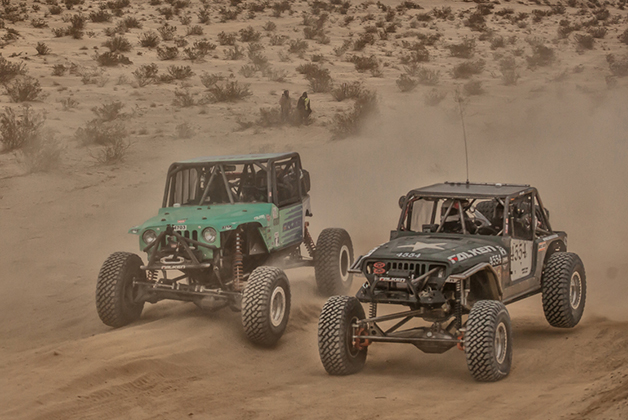
Jimmy's 4x4 built the six spec-vehicle chassis to mimic the silhouette of a JK Jeep Wrangler. The frames were finished by Cole's Hammerking crew along with the Dust Junkies and LJ Engineering, capped off by Jeep-like body panels and a Liberty grille. Cole wanted them to be over-built as far as safety and suspension, so they utilize 2-inch frame tubing and three-inch Fox shocks and coilovers, and ride on Falken's DOT-approved Mud Terrain tire. Cole also wanted them underpowered enough so that novice drivers couldn't use excess horsepower to destroy the rigs on the rocks. That's where Mopar comes in, providing 5.7-liter HEMI crate engines, each with 400 horsepower. Cole said he "picked the engine because it's the one in my wife's Durango, and it's a great little motor."
He was actually just as happy that Chrysler's finally released the engine so it can be tuned as needed. "It's the Mopar crate engine they sell, but now you can get it without the CAN BUS system – that means you can get HEMI's turnkey controller. Chrysler wouldn't release an ECU that didn't need all the other 'stuff,' which is why the LS motor rules this sport, because with that you could get a crate motor without the other system. This is finally a race-ready motor from Chrysler."
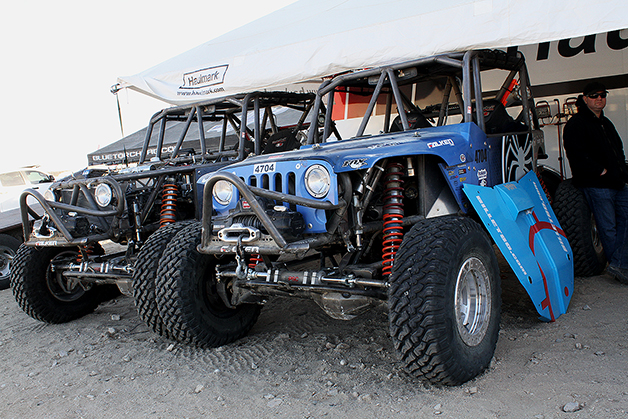
Cole said he wanted the spec racers to be "fun to drive, predictable and neutral," and he apparently got them built right: out of the six started, five finished the EMC race. That's an unheard-of success rate in any Hammers event. They did so well that Cole built up three of them with the best of the post-race parts from all six, and entered them in the King of the Hammers race. One of them, driven by Jim Marsden, came home in 27th out of the 32 classified finishers.
Mopar showed up to do business this year, putting feet on the ground to back up its push into its Jeep Off-Road Performance from Mopar division. The lake bed is overrun with Jeeps and just as many other recreational rigs that look like Jeeps but aren't – they're tube-framed chasses with LS motors and Jeep grilles. Mopar had the Blue Crush Wrangler on display by the start line, and brought four engineers and product planners to walk the crowd and see what owners had on their minds. Said Chrysler rep Scott Brown, "We love the technology and the entrepreneurship – guys here have their own shops and they're building their own trucks." Waving his hat across the plain overrun with lifted and modified Dodge trucks and YJs, TJs and JKs, he said, "The technology, it really trickles up from here."
And when it comes to the spec-series rig, you can guarantee Autoblog will be headed out there later this year to try it out. Before then, stay tuned for the story of Combs' and McIntyre's race on a future episode of The List.
If you aren't familiar with King of the Hammers (KOH), the short story is that it's one of the hardest races in the world, combining desert racing (100-plus-miles-per-hour through the desert like the Baja 1,000), rock crawling (inching over rocks the size of Chevrolet Suburban SUVs at 3 mph, like Moab) and rock racing (higher-speed rocky sections). That sentence might not seem so bad, but here are the stats: this year's race was 198-miles long; competitors came from 31 states and 8 countries; it took the winner a few minutes more than 8 hours to finish; the time limit for competitors is 14 hours, and out of 158 starters, only 32 made it home before the cutoff. The rest, in the seat for more than 14 hours, were still trying to get their trucks through gargantuan quarry obstacles with names like Sledgehammer, Wrecking Ball and Chocolate Thunder. At 10:00PM. Having been racing in the dark for five hours already. It's that hard.
For the long story, check out our pre-race post and race recap from last year's event, the first time we'd been to KOH and realized that a new Mad Max sequel is made every year on a dry lake bed north of Palm Springs, not in a studio.
Read on to enjoy our report on the race, on last year's King Randy Slawson, and on Autoblog series hosts Jessi Combs and Patrick McIntyre of The List winning one of the week's races using one of the Mopar-powered spec-series rig that you can rent to run the Hammers yourself.
Hammer time hasn't been this awesome since MC wouldn't be touched.

The action goes on for a solid seven days, day and night, during the week of racing known as King of the Hammers. As for the race itself, drivers leave the Start/Finish line in pairs at 30-second intervals. The race is three laps, the first one a big loop out into the desert, the second two being figure-eights through the various rock impasses called The Hammers. Lap 1 was 52 miles through the desert, Lap 2 was 67-miles long, and Lap 3 was 79-miles long because it includes a couple of extra trails that don't need to be done on the previous laps. A driver's choice feature of the race is that they can decide which lap they want to climb a rock trail called Backdoor. Some decide to get it out of the way on the first lap, others wait until the third lap when attrition has hopefully thinned the field.
Loren Healy Is Your New King Of The Hammers

New Mexico man Loren Healy is the second two-time winner of KOH, having won in 2010, after Shannon Campbell did the double in 2008 and 2011. Swapping last year's independent front suspension rig for a solid axle this year, Healy and his co-driver left the line in ninth just after 8:00AM, passed everyone else in front of him over the first two laps and stayed out of trouble until the third lap – up to that point he said, "The day went perfect." The lead had been changing all day between the top qualifiers and a number of former Kings, all battling at the front either on time or physically in the lead and all of whom met misery on the last lap.
Last year's King, Randy Slawson, said, "I've never seen so many lead changes at a KOH race." After a number of early mechanical issues he was in second place with just 30 miles to go before he lost his power steering; the hydraulic steering line had been rubbing against an injector line, wearing a hole in each. Slawson fixed the steering line, which took two hours, but lost a cylinder for the rest of the race and he and co-driver/brother Mike Slawson crossed the line in ninth.
For Healy, halfway through the lap the rear-mounted jack slid out of its mount and "wiped out the radiator," busted a wiring harness and shorted wiring which then burst into flame under the dashboard. He made it to his remote pit, where they cut the radiator in half and filled it with "eight cans of stop-leak and a little bit of coolant," turned on the one remaining fan and he got back in the race.



Then he broke his rig's U-joint on the last rock section of the day and was left with a three-wheel drive truck. That meant he had to winch out of terrain he should have been able to drive over. The duo got out of that, then got beached on a sand hill. With nowhere to winch from and in the physical lead Healy thought his race was done, but a backmarker gave him a winch off the dune and he was back in it (competitors can assist one another, but they can't get help during the race from their own teams). He did the last 30 miles with his engine in safe mode, unable to get beyond 2,000 rpm, coolant all gone and the engine temp at 250 degrees. But he did it in first place.
The most succinct thing he had to say about the win that took 8:03.25: "It was brutal, brutal, brutal. That was the worst race I've ever finished."




Healy wasn't first across the line, though – that honor went to Tom Wayes, who raced without a co-driver in an IFS buggy that was comically fast all day. Wayes qualified in second place and ran in first place from not long after the start. He didn't carry a spare tire, and he was still so fast – and lucky – that when his front left tire burst several miles before the line, he kept running and crossed the finish on three tires and a rim, still physically in first. But he missed a highway checkpoint and the helicopter caught it when he skipped a rock trail called Elvis, and he was handed a 1:10:00 time penalty that dropped him to seventh place.
That wasn't the only penalty at the front. Healy crossed the line just ahead of Derek West, and since West started about a minute before Healy, West was initially classified in second place. Later, when tracking was pulled from the on-board computer, it was found that West had also missed Elvis and was given a 25-minute time penalty, dropping him to fifth place – a shame for the racer from Missouri and great guy we profiled last year.



That promoted Tony Pellegrino, owner of GenRight Offroad and another who described his day as "brutal," into second place. Pellegrino, who's finished in second place once before in five starts, said his goal was to "pick people off toward the end without beating up our car. The goal was to get to the end." The penultimate step on the podium is an excellent reward for such a modest goal, at the same time as it shows how much the race can reward a day of soild, steady running.
Bill Baird, at 64 years old, the oldest man in the race, nabbed third on his third time competing after having not even finished the previous two. He also did it driving alone – he winched his own car when needed, he got three flats during the race and was the only guy in the top five without a co-driver. Baird's been racing for longer than many of us have been alive and is a former ARCA Champion, raced stock cars, has done three Sprint Cup races, is in the Talledega Hall of Fame and at some point found time to be a stunt pilot in a Mig-17. Said a hugely excited Baird after the race, "Just because you're getting older doesn't mean you can't do things."
The rest of the top ten and field can be seen at the official timing website. As for other notables, pole-sitter Nick Nelson ran out of gas on Lap 1 and later lost his engine on the same lap. Two-time winner Shannon Campbell blew his transmission on the first lap and was out of the race. He then joined his son Wayland Campbell's pit crew, and helped his son - who's a senior in high school - finish in 15th. Former King Jason Scherer blew his front CV joints on the last lap and bowed out. Former King Erik Miller looked all set for the win with a lead of ten minutes coming into the final stretch, having passed Healy on Lap 3, but blew an orbital valve on a rock section. He ran – physically ran – to his remote pit, got the part, ran back to his rig, fixed it, and crossed the line in 25th, after 12 hours and 44 minutes. That's how the Hammers go.
Last Year's King, Randy Slawson, And Bomber Fabrications

Trying to get more perspective on who the men and women in the helmets are, we managed to get some time with last year's King, Randy Slawson, who won the race with his brother Mike Slawson as co-driver. Racers Channel did an excellent profile on Slawson that deserves a watch.
A laid-back guy originally from Oregon, he moved to California about a dozen years ago and started running The Hammers years before the race began – in fact, it was getting to know guys like Slawson that gave Cole the idea to start the race. This was back when groups would come out with picnics and blankets, planning to spend an entire day getting up just one of the rock trails like Sledgehammer. And that's also part of what made the race so incredible – nobody believed that you could climb a dozen such trails in one day, and the idea of climbing those dozen trails twice, as well as making a high-speed desert run, as well as rock racing, in the same vehicle in the same day... well, that was impossible. But here we are having just finished the eighth running.
He first started running The Hammers in a Toyota pickup he modified himself, and that eventually turned into opening his shop, Bomber Fabrication, to build high-dollar, high-horsepower sand cars (buggies) – they'd sell for anywhere from $50,000 to $150,000 and get 1,200 horsepower from twin-turbo motors.

When Slawson says he's one of the few to race and win The Hammers with a car he built, he doesn't mean he has a company that builds his cars for him, he means he's one of the men wielding the tools – Bomber is really just Slawson and one other guy, building rigs to suit Slawson's philosophy. Bomber's pedigree is already impressive thanks to that philosophy – this year there were three Bomber Fab rigs in the race. That success is not surprising considering his ideas echo the words you hear from engineers at car companies like Porsche and Ferrari; designers like McLaren's Gordon Murray and Lotus' Colin Chapman.
"I was working in sand cars and that's where I began to think about building a simple car. I pushed myself to try things." His brother Mike elaborated: "He's adamant about anything that goes on the car. He'd say, 'Do we really need another tube or gusset or weld?,' or 'These reflectors are too heavy. Can we drill holes in them?'"
Every car he's built since his first, in 2008, has been an evolution of the one before. "I don't build two cars the same," he said. "I like things simple. With each car I want to get better with clearances or mountings or whatever." He is also focused: unlike most other competitors, he lives just 90 miles away, KOH is the only Ultra4 race he does and he builds his trucks with the sole intention of winning the scepter.

In a sport where the average truck can weight 4,500 or 5,500 pounds, Slawson got his truck down to 3,870 pounds this year. His 2013 victory brought in more sponsors, more customers and more money, and "better components is all about the issue of money," he said. "Of late, that's less of an issue."
The biggest difference between last year's rig and this year's, and where he focused his efforts, is the wheels, axles and driveline. "When your front axle, wheels and tires weigh 1,200 pounds and the rear weighs 800 pounds (the wheels and 40-inch tires alone are 130 pounds), getting the unsprung weight down is huge," he said. The new arrangement has lost 100 pounds in the front, 80 pounds in the back. "I noticed it right away – the wheels move up and down much faster."
Here's the kind of difference a win and a year's worth of sponsorship deals has made. Last year's rig was built in six weeks of 12-hour days and, for a cost-saving example, used eight-lug one-ton-truck hubs that Slawson got from Pick-A-Part at $17 per hub. This year's rig was built in 45 working days with time off for holidays, and uses a fabricated, unitized, 6-bolt unit-bearing hubs, surrounded by custom knuckle guards, bracketing and trusses and a custom steering arm. In back, in the middle of the Spidertrax housing, is a ten-inch, rim-polished trophy truck differential with a 5:43 gear reduction. Hanging out at the ends are 39.5-inch BFG KR2 prototype tires on BTR wheels.

The engine was built by Custom Built Motors, a 6.2-liter LS3 that's been bored out to 7.0-liters (425 cubic inches), with ported and polished heads, and a Bomber Fabrications alternator relocation kit to get the alternator higher up, leaving more room for suspension travel. "The point is to keep engine low and forward and allow for the suspension and driveline, and the 6.2-liter is an amazing starting point," Randy said, "light, compact, well supported in the aftermarket, with a wide power band and no lag." He ran the exhaust up above the engine to make more room below for – yet again – suspension travel, and moved the coils behind the engine to keep the plug wires away from the manifold, then shaved the bosses and powdercoated the valve covers. The 600-horespower motor sends power to a 4L80E, computer-controlled, four-speed overdrive transmission. The cockpit tunnel has one lever for the front differential and one for the rear differential.
The $10,000 worth of custom shocks come from King – Slawson and the suspension company having worked to develop a package specifically for his rig. There's a 14-inch stroke up front, in back there's a 16-inch stroke and 20 inches of wheel travel, 13 of it being up-travel instead of droop travel. A few other notes on the build: the water lines are plumbed into the tube chassis so no extra hoses are required to get water back to the radiator; he has to refill the 26-gallon fuel cell 3 times during the race, but the smaller cell means the back end loses less weight and the truck behaves more consistently when the cell is full or nearly empty; has to refill three times, weight is a big deal, tune the truck for a bigger cell then you lose the weight the truck acts differently; he uses a go-kart steering wheel "because I like the size;" he calls his front bumper "The chrome horn."
Before the race, Slawson couldn't peg the odds on a victor. "If I could make a bet for a million bucks who is going to win this year, I couldn't narrow it down." Even though the mechanical issues dropped him to a ninth-place finish, Slawson said afterward "I was in and out of the car all day long dealing with 'new-car blues,' but I've never had such a fast car." It's likely we'll see it again next year – refined, of course. And it's probably safe to bet a million that – eventually – we'll see him as King again.
Autoblog's video series "The List" Demonstrated Mopar-Powered Hammering


The rig in the pic above is #4703 in the 114-mile Smittybilt Every Man Challenge (EMC) support race. In the driver's seat is Jessi Combs, in the passenger seat is Patrick McIntyre, hosts ofAutoblog series The List, and the two of them would earn the class win when the driver who finished before them was penalized for accidentally shorting the course, gaining a 30-minute advantage in the process. Combs' win marks the first-ever Hammers victory for a woman, as well. Not bad considering their rig had mechanical problems and couldn't even finish qualifying or do any pre-running. Even better for you readers is this: you can do the same thing. Well, you can race the rig – you'll have to be as good as Combs in order to win.
KOH impresario Dave Cole wanted to add a spec class to the Every Man Challenge, and ended up doing even more than that. Now, professional racers and first-timers who want to get a taste of The Hammers can rent a rig for $15,000 and contest the EMC or other Ultra4 Racing events, or they can rent a rig for $1,500 for the weekend and Cole himself will meet the renters in the Johnson OHV area and show them how to run The Hammers.

Jimmy's 4x4 built the six spec-vehicle chassis to mimic the silhouette of a JK Jeep Wrangler. The frames were finished by Cole's Hammerking crew along with the Dust Junkies and LJ Engineering, capped off by Jeep-like body panels and a Liberty grille. Cole wanted them to be over-built as far as safety and suspension, so they utilize 2-inch frame tubing and three-inch Fox shocks and coilovers, and ride on Falken's DOT-approved Mud Terrain tire. Cole also wanted them underpowered enough so that novice drivers couldn't use excess horsepower to destroy the rigs on the rocks. That's where Mopar comes in, providing 5.7-liter HEMI crate engines, each with 400 horsepower. Cole said he "picked the engine because it's the one in my wife's Durango, and it's a great little motor."
He was actually just as happy that Chrysler's finally released the engine so it can be tuned as needed. "It's the Mopar crate engine they sell, but now you can get it without the CAN BUS system – that means you can get HEMI's turnkey controller. Chrysler wouldn't release an ECU that didn't need all the other 'stuff,' which is why the LS motor rules this sport, because with that you could get a crate motor without the other system. This is finally a race-ready motor from Chrysler."

Cole said he wanted the spec racers to be "fun to drive, predictable and neutral," and he apparently got them built right: out of the six started, five finished the EMC race. That's an unheard-of success rate in any Hammers event. They did so well that Cole built up three of them with the best of the post-race parts from all six, and entered them in the King of the Hammers race. One of them, driven by Jim Marsden, came home in 27th out of the 32 classified finishers.
Mopar showed up to do business this year, putting feet on the ground to back up its push into its Jeep Off-Road Performance from Mopar division. The lake bed is overrun with Jeeps and just as many other recreational rigs that look like Jeeps but aren't – they're tube-framed chasses with LS motors and Jeep grilles. Mopar had the Blue Crush Wrangler on display by the start line, and brought four engineers and product planners to walk the crowd and see what owners had on their minds. Said Chrysler rep Scott Brown, "We love the technology and the entrepreneurship – guys here have their own shops and they're building their own trucks." Waving his hat across the plain overrun with lifted and modified Dodge trucks and YJs, TJs and JKs, he said, "The technology, it really trickles up from here."
And when it comes to the spec-series rig, you can guarantee Autoblog will be headed out there later this year to try it out. Before then, stay tuned for the story of Combs' and McIntyre's race on a future episode of The List.










Sign in to post
Please sign in to leave a comment.
Continue